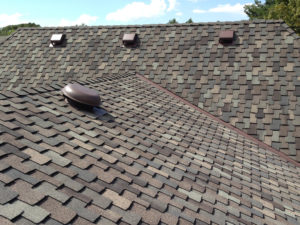 In basic terms, a ventilation system provides a flow of air that exhausts trapped air and pulls in fresh air from the outside. You may have heard that it is important to ensure that your roof is properly ventilated, but you may not understand the problems that can result from poor roof ventilation.
In basic terms, a ventilation system provides a flow of air that exhausts trapped air and pulls in fresh air from the outside. You may have heard that it is important to ensure that your roof is properly ventilated, but you may not understand the problems that can result from poor roof ventilation.
Energy Consumption
In Austin, the greatest energy costs are usually related to cooling. Without proper ventilation, the sun can cause heat to build up in the attic space; on a day with a temperature of 90 degrees Fahrenheit, the attic temperature can be as much as 140 degrees. The heat will radiate into the interior of the home, making the living space less comfortable and forcing the HVAC system, refrigerators and freezers to work harder. The additional work can increase your energy bills, but it can also shorten the life of all appliances that rely on compressors for cooling.
Damage to Roof and Structural Components
Excess heat trapped in the attic can play havoc with asphalt shingles, causing them to warp and leading to premature deterioration. In fact, many manufacturers have clauses in their warranties stating that the warranty is void unless the structure has adequate roof ventilation. However, it is important to remember that damage can result regardless of the type of roofing system in place; excessive heat can also warp the roof decking. In addition, poorly ventilated attics tend to trap moisture that can rot the rafters, cause the insulation to deteriorate and rust metal components. The moisture can also allow mildew and mold to grow, potentially affecting the quality of the air in the interior living areas. Furthermore, the moisture can penetrate the insulation and cause damage or stains to the ceilings in the structure’s interior. Accumulated moisture is common during the winter months and in homes lacking a vapor barrier, but cooking, hot showers and other routine activities can allow water vapor to build up in the attic space regardless of the season.
What Constitutes Proper Ventilation?
There are many different ways to ventilate your attic space, so you should ask a reputable roofing contractor to inspect your property to determine whether you need additional ventilation. Although many factors can influence the size and type of ventilation, industry guidelines provide minimum acceptable conditions. The general rule is that you need at least 1 square foot of venting per 150 square feet of floor space in the attic. However, less ventilation may be needed if the open ventilation is divided evenly between the ridge or other upper areas and the eaves, soffits or other lower areas. When ventilation is split between upper and lower areas, the upper areas handle most of the exhaust and the lower areas handle most of the intake. However, regardless of the method used, it is critical that all vents remain unobstructed. Keep them clean, make sure that insulation is not blocking the vents and do not place boxes, furniture or other solid objects in front of the vents.
Alpha Roofing Can Help
Alpha Roofing is an Austin residential roofing expert and an award-winning roofing company providing customers in Austin. We install skylights, flashing, asphalt shingles, siding and metal roofing systems. We also offer roof repairs, roof inspections, and chimney repairs. Our crew members are dedicated to delivering exceptional work and superior customer service. We are a highly rated company with impeccable references. If you would like to request a free estimate, you can call (512) 777-1086 or fill out our online form.
